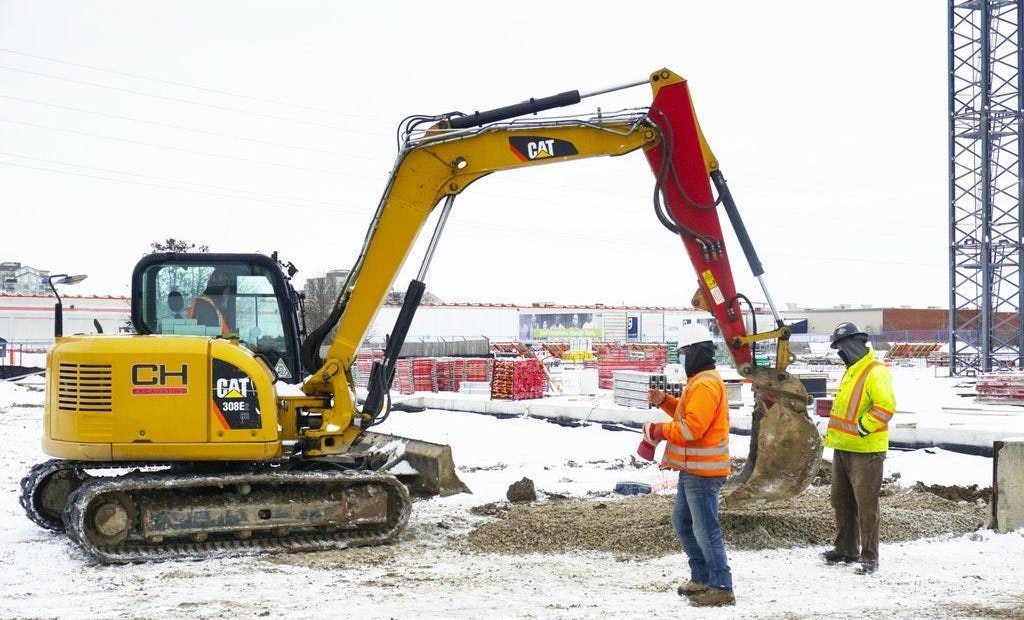Interested in Excavating?
Get Excavating articles, news and videos right in your inbox! Sign up now.
Excavating + Get AlertsTo avoid the challenges of snow, ice and frozen ground, and weather-related work stoppages, contractors will often stop working early in the winter season and delay starting projects in late winter. But companies that do that lose out on the potential to generate revenue during that time. Working two weeks later into the winter season and starting two weeks earlier coming out of winter can provide a nice, extra boost to revenue potential.
“The ground doesn’t freeze after one cold day or one day of snow. The ambient temperature has to be very cold consistently for days or there has to be ice on the ground in order for the ground to be frozen; we have very little issues breaking ground during winter,” says Dennis Mikula, president of Mikula Contracting, an excavation and demolition company based out of New Jersey.
Digging into frozen ground requires some extra effort and equipment to complete the work, and there are a few strategies for achieving it.
1. Upgrade your equipment size
This is especially true when using compact equipment.
“Most machines will take a little longer to get through frozen ground, but compact equipment may struggle too much,” Mikula says. “The most important thing when breaking through frozen ground is power.”
Upgrading your equipment size has the side benefit of also increasing production to offset delays caused by the weather or to get ahead.
2. Change your attachment
If you only have smaller machines on site, it may be easier to swap out the attachment than it is to swap out the machine. Remove the general purpose bucket and fasten a bucket with sharper cutting edges and more durable teeth.
Although increasing equipment size will increase production when excavating, it can decrease production when trenching since a larger bucket removes a wider swath of dirt that will later need to be backfilled.
3. Use a ripper
If you have a dozer with a ripper attachment, you can use that to cut through the top few inches of earth before excavating in winter. Or you can equip the excavator with a ripper.
“When the ground freezes, it’s only the top few inches that are frozen. Once you get below that, it’s back to normal operations,” says Mikula.
4. Hydroexcavate
The high-pressure water used with vacuum trucks helps. High-pressure water is sometimes used in demolition applications to cut through materials such as concrete, so high-pressure water is plenty capable of cutting through ice or frozen ground.
5. Heat the ground
You can use heated blankets to cover the excavation area and warm the top layer of the earth. This will make it easier for equipment to break through it, but this method takes longer than previously mentioned solutions.
Other options include throwing charcoal on the area and lighting it on fire or building a temporary shelter over the excavation area prior to the cold or snow.
6. Cover the ground
If you cover the excavation area with plywood, for example, before the drop in temperature or the snowfall, you can keep the ground warmer and prevent it from freezing in the first place. If ice forms, it will form on the exposed side of the wood — not the ground.
Covering the excavation area — even with only a tarp — has the side benefit of making snow removal easier.
“You have to be able to access the excavation area. Clear off the snow and ice first; you don’t want to dig blind,” Mikula says.
Additional considerations
Mikula recommends clearing all the snow and ice on a job site to prevent slips and other safety hazards. And ensure there is a warm place in which everyone can take breaks from the cold.
“Just as people need to cool off and rehydrate in the summer, they need to warm up in the winter to prevent cold stress.”
Also, make sure all of your equipment is winter-ready and let engines idle for longer when you first start them, because it will take longer for them to reach their operating temperature. This also applies to a machine’s hydraulic components. Activate the attachment for a few seconds and then pause for a few seconds. Repeat this pattern for two minutes.
Constantly check the weather.
“The weather forecast can change throughout the day, so I’m constantly checking it, says Mikula. “Knowing the weather forecast helps me know what work is possible, so I can plan activities in a way that keeps the project on time and on budget.”
About the author
AEM is the North American-based international trade group representing off-road equipment manufacturers and suppliers, with more than 950 companies and 200-plus product lines in the agriculture and construction-related sectors worldwide. AEM has an ownership stake in and manages several world-class exhibitions, including CONEXPO-CON/AGG.






